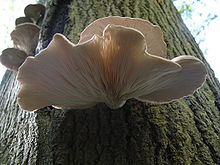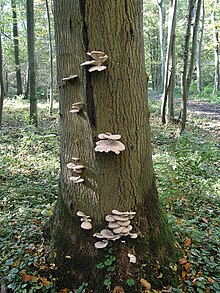Pleurotus ostreatus
| Pleurotus ostreatus | |
|---|---|

| |
| Scientific classification | |
| Domain: | Eukaryota |
| Kingdom: | Fungi |
| Division: | Basidiomycota |
| Class: | Agaricomycetes |
| Order: | Agaricales |
| Family: | Pleurotaceae |
| Genus: | Pleurotus |
| Species: | P. ostreatus
|
| Binomial name | |
| Pleurotus ostreatus | |
| Pleurotus ostreatus | |
|---|---|
| Gillsonhymenium | |
| Capisoffset | |
| Hymeniumisdecurrent | |
| Stipeisbare | |
| Spore printiswhite | |
| Ecology issaprotrophic | |
| Edibility ischoice | |
Pleurotus ostreatus,theoyster mushroom,oyster fungus,hiratake,orpearl oyster mushroomis a commonedible mushroom.[2] It is one of the more commonly sought wild mushrooms, though it can also becultivatedon straw and other media.
Description
[edit]The mushroom has a broad, fan or oyster-shaped cap spanning2–30 centimetres (3⁄4–11+3⁄4inches);[3]natural specimens range from white to gray or tan to dark-brown; the margin is inrolled when young, and is smooth and often somewhat lobed or wavy. The flesh is white, firm, and varies in thickness due tostipearrangement. Thegillsof the mushroom are white to cream, and descend on the stalk if present. If so, the stipe is off-center with a lateral attachment to wood. Thespore printof the mushroom is white to lilac-gray, and best viewed on dark background. The mushroom's stipe is often absent. When present, it is short and thick. It has the bittersweet aroma ofbenzaldehyde(which is also characteristic of bitter almonds).[4]


Similar species
[edit]It is related to the similarly cultivatedPleurotus eryngii(king oyster mushroom). Other similar species includePleurocybella porrigens,Hohenbuehelia petaloides,and the hairy-cappedPhyllotopsis nidulans.[5]
Omphalotus nidiformisis a toxic lookalike found in Australia and Japan. In North America, the toxicmuscarine-containingOmphalotus olivascens(the western jack-o'-lantern mushroom) andClitocybe dealbata(the ivory funnel mushroom) both bear a resemblance toP. ostreatus.
Name
[edit]Both the Latin and common names refer to the shape of the fruiting body.[2]The Latinpleurotus(side-ear) refers to the sideways growth of the stem with respect to the cap, while the Latinostreatus(and the English common name,oyster) refers to the shape of the cap which resembles the bivalve of the same name.[2]The reference tooystermay also derive from the slippery texture of themushroom.[2]The namegrey oyster mushroommay be used forP. ostreatus.[6]
Distribution and habitat
[edit]The oyster mushroom is widespread in many temperate and subtropical forests throughout the world, although it is absent from thePacific NorthwestofNorth America,being replaced byP. pulmonariusandP. populinus.[7]It is asaprotrophthat acts as a primary decomposer of wood, especially deciduous trees, and beech trees in particular.[8]It is awhite-rot wood-decayfungus.
The standard oyster mushroom can grow in many places, but some other related species, such as the branched oyster mushroom, grow only on trees. They may be found all year round in the UK.
While this mushroom is often seen growing on dying hardwood trees, it only appears to be actingsaprophytically,rather than parasitically. As the tree dies of other causes,P. ostreatusgrows on the rapidly increasing mass of dead and dying wood. They actually benefit the forest by decomposing the dead wood, returning vital elements and minerals to the ecosystem in a form usable to other plants and organisms.[2] Oyster mushroomsbioaccumulatelithium.[9]
Ecology
[edit]Although predatory behavior on nematodes has evolved independently in all major fungal lineages,[10]P. ostreatusis one of the few known carnivorous mushrooms.[citation needed]Itsmyceliacan kill and digestnematodes,which is believed to be a way in which the mushroom obtainsnitrogen.[10]
Uses
[edit]Commercialcultivationof this mushroom first began in Germany as a subsistence measure duringWorld War I,[11]and it is now grown commercially around the world for food.
Culinary
[edit]Oyster mushrooms are used inCzech,Polish,andSlovakcontemporary cuisine in soups and stews in a similar fashion to meat, as well as breaded to become a vegetarian alternative to thekotletin Polish dishes.[12][13]The oyster mushroom is a choiceedible,[3]and is adelicacyinJapanese,KoreanandChinese cuisine.[citation needed]It is frequently served on its own, in soups, stuffed, or instir-fryrecipes withsoy sauce.Oyster mushrooms may be used in sauces, such asoyster sauce.The mushroom's taste has been described as mild with a slight odor similar toanise.The oyster mushroom is best when picked young; as the mushroom ages, the flesh becomes tough and the flavor becomes acrid and unpleasant.[14]
Some toxicLentinellusspecies are similar in appearance, but have gills with jagged edges and finely haired caps.[15]
Other uses
[edit]The pearl oyster mushroom is also used to createmyceliumbricks,mycelium furniture,and leather-like products.[citation needed]
Oyster mushrooms can also be used industrially formycoremediationpurposes. Oyster mushrooms were used to treat soil that had been polluted with diesel oil. The mushroom was able to convert 95% of the oil into non-toxic compounds.[16]P. ostreatusis also capable of growing upon and degradingoxo-biodegradable plasticbags;[17]it can also contribute to the degradation ofgreen polyethylene.[18]
See also
[edit]References
[edit]- ^Kummer, P.(1871).Der Führer in die Pilzkunde(1st ed.).
- ^abcdeDavidson, Alan; Jaine, Tom (2014)."Oyster mushroom".In Jaine, Tom (ed.).The Oxford Companion to Food(3rd ed.). Oxford University Press.doi:10.1093/acref/9780199677337.001.0001.ISBN978-0-19-967733-7.
- ^abMiller Jr., Orson K.;Miller, Hope H. (2006).North American Mushrooms: A Field Guide to Edible and Inedible Fungi.Guilford, CN:FalconGuide.p. 142.ISBN978-0-7627-3109-1.
- ^Beltran-Garcia, Miguel J.; Estarron-Espinosa, Mirna; Ogura, Tetsuya (1997). "Volatile Compounds Secreted by the Oyster Mushroom (Pleurotus ostreatus)and Their Antibacterial Activities".Journal of Agricultural and Food Chemistry.45(10): 4049.doi:10.1021/jf960876i.
- ^Davis, R. Michael; Sommer, Robert; Menge, John A. (2012).Field Guide to Mushrooms of Western North America.Berkeley:University of California Press.pp. 132–3.ISBN978-0-520-95360-4.OCLC797915861.
- ^Hall, Ian R. (April 2010)."Growing mushrooms: the commercial reality"(PDF).Lifestyle Farmer:42–45.Retrieved26 January2012.
- ^Trudell, S.; Ammirati, J. (2009).Mushrooms of the Pacific Northwest.Timber Press Field Guides. Portland, Oregon: Timber Press. p.134.ISBN978-0-88192-935-5.
- ^Phillips, Roger (2006).Mushrooms.p. 266.ISBN0-330-44237-6.
- ^de Assunção, Laélia Soares; da Luz, José Maria Rodrigues; da Silva, Marliane de Cássia Soares; Vieira, Patrícia Aparecida Fontes; Bazzolli, Denise Mara Soares; Vanetti, Maria Cristina Dantas; Kasuya, Maria Catarina Megumi (2012)."Enrichment of mushrooms: An interesting strategy for the acquisition of lithium".Food Chemistry.134(2). Elsevier BV: 1123–7.doi:10.1016/j.foodchem.2012.03.044.ISSN0308-8146.PMID23107736.
- ^abLee, Ching-Han; Chang, Han-Wen; Yang, Ching-Ting; Wali, Niaz; Shie, Jiun-Jie; Hsueh, Yen-Ping (2020-03-02)."Sensory cilia as the Achilles heel of nematodes when attacked by carnivorous mushrooms".Proceedings of the National Academy of Sciences.117(11): 6014–22.Bibcode:2020PNAS..117.6014L.doi:10.1073/pnas.1918473117.PMC7084146.PMID32123065.
- ^Eger G, Eden G, Wissig E (July 1976). "Pleurotus Ostreatus - breeding potential of a new cultivated mushroom".Theor Appl Genet.47(4): 155–63.doi:10.1007/BF00278373.PMID24414617.
- ^"Slovak oyster mushroom recipes".Ringier Axel Springer SK.Retrieved2015-07-21.
- ^"Jak przyrządzić boczniaki? Jak długo gotować lub smażyć ten rodzaj grzybów?".przepisy.pl. 2021-11-15.Retrieved2024-01-19.
Wyśmienicie smakują w wersji zarówno gotowanej, jak i smażonej. Można dorzucić je zup i gulaszów lub zamienić w wegetariański kotlet w chrupiącej panierce.
- ^"How To Harvest Oyster Mushrooms?".Forest Wildlife. 16 August 2022.Retrieved2022-08-16.
- ^Davis, R. Michael; Sommer, Robert; Menge, John A. (2012).Field Guide to Mushrooms of Western North America.Berkeley:University of California Press.p. 30.ISBN978-0-520-95360-4.OCLC797915861.
- ^Rhodes, Christopher J. (January 2014)."Mycoremediation (bioremediation with fungi) – growing mushrooms to clean the earth".Chemical Speciation & Bioavailability.26(3): 196–8.doi:10.3184/095422914X14047407349335.ISSN0954-2299.S2CID97081821.
- ^da Luz JM, Paes SA, Nunes MD, da Silva Mde C, Kasuya MC (2013)."Degradation of oxo-biodegradable plastic by Pleurotus ostreatus".PLoS One.8(8): e69386.doi:10.1371/journal.pone.0069386.PMC3744528.PMID23967057.
- ^da Luz JM, Paes SA, Ribeiro KV, Mendes IR, Kasuya MC (2015)."Degradation of Green Polyethylene by Pleurotus ostreatus".PLoS One.10(6): e0126047.doi:10.1371/journal.pone.0126047.PMC4468114.PMID26076188.
Further reading
[edit]- Lincoff, G.H. (1981).National Audubon Society Field Guide to North American Mushrooms.Knopf.ISBN978-0-394-51992-0.
- Spahr, D.L. (2009).Edible and Medicinal Mushrooms of New England and Eastern Canada.North Atlantic Books.ISBN978-1-55643-795-3.
External links
[edit] Media related toPleurotus ostreatusat Wikimedia Commons
Media related toPleurotus ostreatusat Wikimedia Commons- Video footage ofPleurotus ostreatus
- Mushroom-Collecting – Oyster mushrooms
